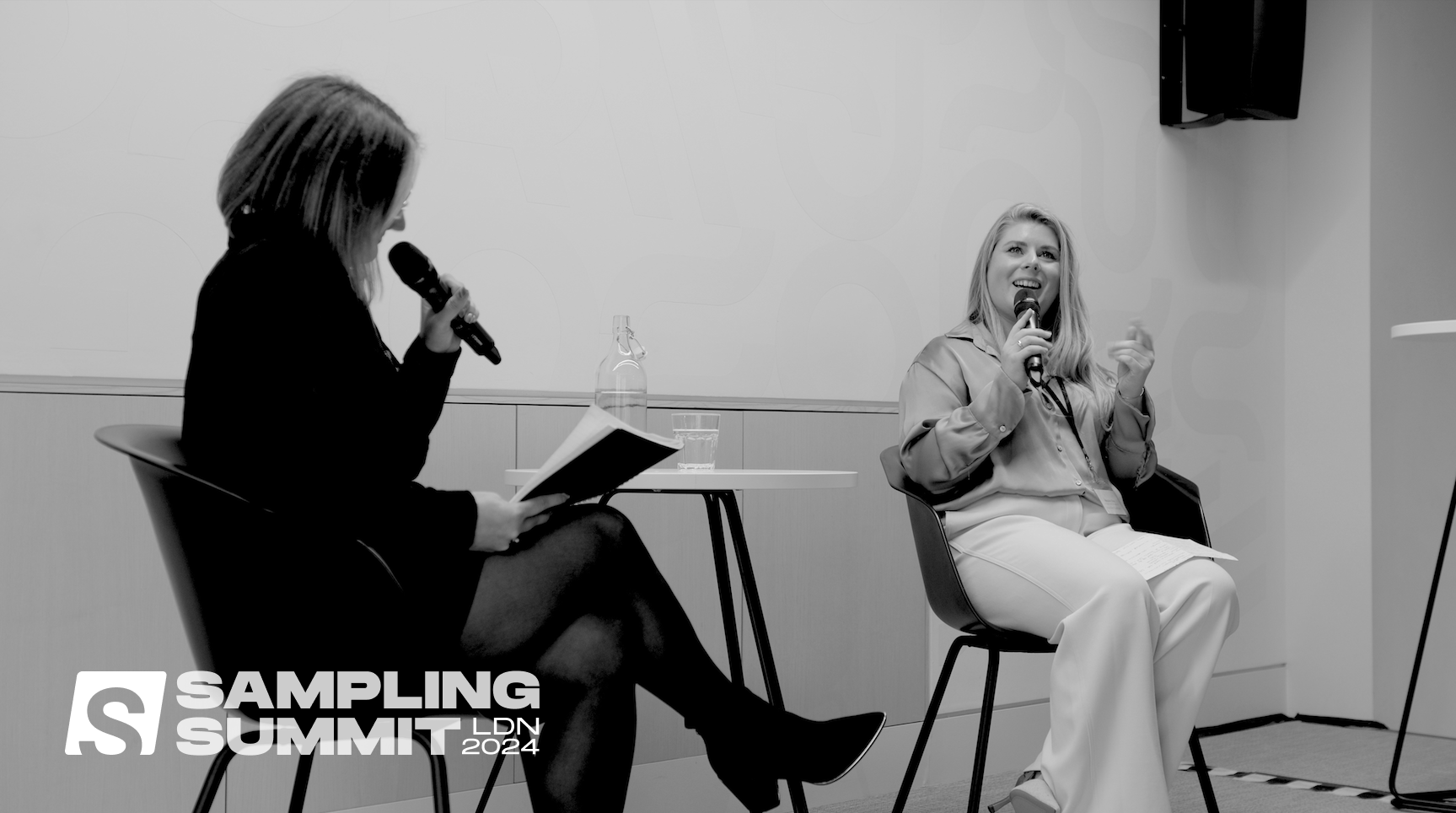7 key takeaways from the SoPost Sampling Summit | London 2024

Our first SoPost Sampling Summit in London was a resounding success! We brought together industry leaders to share insights, strategies and experiences on maximizing the impact of digital sampling in marketing.
There were so many valuable takeaways from the day – too many to list! Don't worry if you weren't there – we've compiled our top 7 highlights for your 2024 sampling strategy and beyond...
1. Digital sampling allows your budget to stretch further
Every pound, dollar or euro counts! Efficient budget use is crucial for both established and emerging brands, especially in today’s economic climate. Digital sampling can deliver impressive results at a fraction of the cost of more traditional marketing tactics.
Amelia Reynolds from Matrix shared how digital sampling helped ARKIVE Headcare maximize their limited budget:
“We were working with smaller budgets and smaller quantities, and we really wanted to build that customer base from the ground up, which was a perfect use case for digital sampling.
“So we partnered with SoPost and Marie Claire Beauty Drawer to connect with as many consumers as possible to ensure our pounds were working hard and stretching as far as they could.”

"We partnered with SoPost and Marie Claire Beauty Drawer to connect with as many consumers as possible to ensure our pounds were working hard and stretching as far as they could."
— Amelia Reynolds, Matrix
Angharad Elfyn Jones from Shiseido also emphasized the importance of efficiency within such a large brand group:
“We like to push one Shiseido vision for our brands, and we weren’t really doing that to the best of our abilities.
“I had the overarching view of: let’s streamline ourselves, let’s be efficient with our budgets and let’s be clear on what each brand can do. From an economies-of-scale point of view, we were also able to save some money by doing a group partnership which is great in this current climate.”
2. Embrace setbacks as opportunities
Adopting a test-and-learn approach and turning setbacks into opportunities is key to driving digital sampling success. This strategy allows for continuous improvement, enabling brands to adapt quickly and make changes, ultimately improving their campaign results.
Angharad Elfyn Jones shared a valuable lesson with a niche brand in the Shiseido portfolio, highlighting the importance of quick pivots:
“Our influencer campaign on Instagram didn’t deliver what it needed to, so the SoPost team offered us a different opportunity to sample through communities.
“For a niche brand, you really need to know that customer and that they’re looking for a niche fragrance. So moving to a community approach for our smaller, lesser-known brands was a smarter approach.”

"For a niche brand, you really need to know that customer and that they’re looking for a niche fragrance. So moving to a community approach for our smaller, lesser-known brands was a smarter approach."
— Angharad Elfyn Jones , Shiseido
Bella Noakes from Publicis Media also stressed the importance of early partner integration to avoid disappointing results:
“There was this one brand that was doing sampling direct and they brought in the agency last minute. The agency engaged an existing influencer campaign, thinking that the samples would fly. But the samples were under-utilized and that’s because we weren’t brought in at the beginning.
“The key learning is to really match up with the wider media plan and the sampling objective, not to sit in a silo. We want to be seen as an elevation, not a standalone.”

"A key learning is to really match up with the wider media plan and the sampling objective, not to sit in a silo. We want to be seen as an elevation, not a standalone."
— Bella Noakes, Publicis Media
3. Successful teams are agile and innovative, no matter the company size or budget
This leads us nicely to another key theme of the day: embracing agility and innovation to stay relevant and drive growth, whatever that may look like for your brand and company.
“For NARS, innovation is how we keep growing,” declared Angharad Elfyn Jones.
“Keeping our foot on the pedal and driving the brand as a relevant brand today, because there’s a lot of competition from great brands in the market. Data, insights and sampling is how we stay ahead of the others.”
Bella Noakes echoed this sentiment, stressing the possibility of small-scale innovation even for those with smaller budgets:
“I want to see more innovation and brands trying things like Spotify and audio and stepping outside of their comfort zone. We can do that at small-scale budgets. We don’t need jazz hands and massive campaign budgets, we can integrate into the wider plan and trial and learn.”
4. The ripple effect of sampling is bigger than you think
The long-term effects of sampling are undeniable: a sampling campaign can influence purchase decisions months or even years after the campaign has ended, especially if it goes viral.
Jonny Grubin from SoPost recounted a success story for a haircare brand that went viral and resulted in a huge sales uplift:
“What shocked me was two things: firstly, this campaign went viral on TikTok. Secondly, even though consumers were receiving full-size samples that would likely take them out of the market for a period of time, because of the engagement they had from such an amazing offer on TikTok, the brand actually saw a big sales uplift off the back of it.”
Katie Potts from TikTok shared details of a similar success story for a well-known makeup brand that saw a huge surge in demand for the product long after samples ran out:
“We did have a limited number of samples, but once the samples and creatives started going out, people were going mad for it.
“Even when the samples ran out, it was great for the virality of the brand, because when people couldn’t get their hands on the sample, they went and bought the full-size product anyway.”

"Even when the samples ran out, [the campaign] was great for the virality of the brand, because when people couldn’t get their hands on the sample, they went and bought the full-size product anyway.”
— Katie Potts, TikTok
5. Sampling data is your secret weapon to better positioning and messaging
Data is everything, especially for marketers. Brands are getting smarter with their sampling campaign insights to refine and improve future marketing strategies and messaging.
Amelia Reynolds from Matrix emphasized the benefits of personalized data collection:
“By using SoPost and Marie Claire Beauty Drawer, we were able to personalize the question beforehand. So we know from the outset that whoever is opting in actually wants to try the product, and then we’re able to use that data in the amazing round-ups that SoPost provides us to inform future campaigns, future strategy and decisions we’re making.”
Katie Potts from TikTok also highlighted how brands are using feedback data to better educate consumers:
“At TikTok, we see a lot of brands doing work around negative sentiment analysis in-app. They may follow up with consumers to let them know they’re not using the product right and educate them on how to actually use it. So it’s good to call out that it's not all bad.”
And last but not least, Bella Noakes from Publicis Media discussed the value of both positive and negative feedback to better improve your product:
“Take the good and the bad. Brands may not want to sample because they don’t want bad reviews or they don’t want an honest opinion about their product. But that’s why we do it. You can take so much learning from things that don’t go right and things about your product that you need to improve.”

6. Sustainability goes beyond the sampling campaign itself
No sampling summit is complete without discussing the “s” word. A common theme was the importance of eco-conscious practices in every campaign aspect – from product development to supplier partnerships.
“We need to make sure that whatever we’re doing, we’re doing it in the most sustainable way possible, be that with partners, our manufacturing processes and our packaging,” explained Amelia Reynolds.
“With traditional sampling, you’re not sure if it’s going to reach that end consumer and if they’re going to actually use it.
“Whereas digital sampling is sustainable because we have guardrails within our questionnaire to make sure that person actually wants to use the product. We couple that with how we create our product from beginning to end to make sure that’s sustainable.”

"We need to make sure that whatever we’re doing, we’re doing it in the most sustainable way possible, be that with partners, our manufacturing processes and our packaging."
— Amelia Reynolds, Matrix
Angharad Elfyn Jones echoed this sentiment, highlighting the importance of sustainable packaging and consumer engagement:
“Sustainability is a hot topic for all brands. It’s all about being sustainable with our packaging, no wastage and being really mindful about making sure the customer is engaging.
“What is the benefit once they get the sample? From a lifetime customer value point of view, if sampling has been key in their purchasing journey, that’s a sustainable way to drive that extra purchase.”
7. Online and offline channels need to work in harmony
Strategic omnichannel experiences blend the best of online and offline interactions to engage consumers at every touchpoint. And as Bella Noakes highlighted, this approach is increasingly crucial for driving long-term sales growth:
“Everyone wants sales uplift, right? A lot of our clients have new product launches and consumers don’t know they’re in supermarkets. So, how can we drive them to the store after sampling?
“We’re seeing a real drive in integrating sampling into out-of-home (OOH). We can use sampling to get that data collection piece and OOH to drive in-store.”

"You need to be where the customer is and we need to think of the omni-channel view. Both digital and in-store can complement each other, we just need to be clear on what the KPIs are."
— Angharad Elfyn Jones, Shiseido
Angharad Elfyn Jones agrees that offline and online need to work seamlessly together, as long as the goals are clear:
“You need to be where the customer is and we need to think of the omni-channel view. Both digital and in-store can complement each other, we just need to be clear on what the KPIs are.”
Guess what! You can also watch the full Shiseido session here.
Here’s to stretching budgets, turning setbacks into wins and driving both short-term and long-term success! We can’t wait to see how our brands continue to innovate and refine their sampling approaches.
Ready to start planning your next digital sampling campaign? Check out our online product sampling guide.